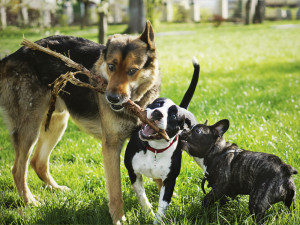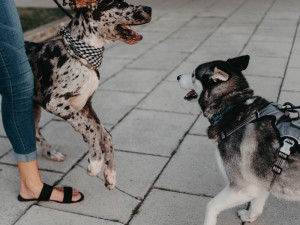Humping. Why, Though?!
Animal behaviourists weigh in on what’s behind all this bumping and grinding

share article
Although we’d love to say we adore absolutely everything about our pups, the act of dog humping definitely falls into the ‘least’ adorable category. Dogs hump the air, they mount pillows and blankets and they can be found poised behind the neighbour’s dog or befriending Uncle Joe’s leg. (What won’t dogs hump?) Pet parents hypothesise that sex, breed, age, reproductive status and even size might provide information about humpers. Most of these hypotheses culminate in questions – “Why do female dogs hump? Aren’t males the humpers?” – or impressions, anything from “It’s just play” or “She’s dominant” to “He’s quite popular!” Aside from the byproduct of allowing us to give humping dogs nicknames like ‘the humping bean’ or ‘sir-humps-a-lot’, what’s actually behind all of this bumping and grinding?
Why do dogs hump?
From tail wagging to barking, dog behaviour is riddled with nuance. A dog’s wagging tailopens in a new tab might convey ‘I’m quite scared’ or ‘This is the best day ever!’ Similarly, the reason why dogs hump is far more complex than it may appear, and there isn’t one simple explanation. That said, there are some likely culprits.
As you might expect, animal behaviour researchers have a lot to say on the topic. For nearly as long as ethologists have studied dogs, they’ve taken note of their tendency to hump outside of reproductive contexts. So, why exactly do dogs hump things? “It’s what dogs do. It’s a completely normal behaviour,” explains Carolyn Walsh, PhD, who studies the nuances of dog behaviour in parks. “Both males and females mount, regardless of whether they are sexually intact or not.”
Normal behaviour
Whether your dog is a leg humper or an air humper, it’s all normal. Peter Borchelt, PhD, and a Certified Applied Animal Behaviourist (CAAB), says: “There are only so many behaviours a dog has access to, and dogs do what is part of their species-typical behaviour. It is something they know how to do.” Since their options are somewhat limited, a dog, rather than scroll Instagram during downtime, might be inclined to get to know a stuffed animal a little better.
Excitement / Arousal
In many cases, mounting is related to a surge of emotion, such as feeling anxious or being aroused (in this context, ‘arousal’ means general stimulation). In an investigation of dog behaviour, Walsh found that the dogs doing the most mounting were also doing the most playing. Walsh explains: “Parks can be quite stimulating, and for those who are highly aroused physiologically, mounting behaviour could easily come out. There can be such a buildup of social motivation and the desire to affiliate that some of that energy spills over into the sexual motivation system. You see sexual behaviour coming out, but it’s mostly out of context.” A dog’s general arousal or anxiety isn’t restricted to the park. Stimulation easily translates to everyday situations: a new person comes over, a new dog is introduced or a dog is cooped up in the house all day.
Dawn Cleary, owner of Blue Cerebus Dog Boutique in the US, attributes mounting exhibited by one of her Golden Retrievers to excitement. “When my frisbee champ catches the frisbee, my littlest one likes to run out and hump her. It’s the only time she does it … sort of like she wants to share in the glory of it being caught.” (Is this the canine equivalent of painting your face and watching the Lionesses?)
Sexual or hormones
Celeste Pongrácz, a Mudi breeder in Hungary, finds that mounting can change with hormonal shifts. “Right now, we live with seven bitches, and when somebody is coming into season or is in season, some dogs want to hump, and others ‘ask’ to be humped. Regardless, it always involves the bitch in season.” Studies find that neutering males can decrease mounting, but certainly doesn‘t stop it in its tracks. After all, there’s more to this than hormones.
Dominance
For some owners, dog mounting equates to dominance and control, words that suggest you might not want your four-legged friend engaging in this behaviour. But what is dominance, and where does mounting fit in? The American Veterinary Society of Animal Behavior defines it as, “A relationship between individual animals that is established by force/aggression and submission, to determine who has priority access to multiple resources such as food, preferred resting spots and mates.”
Is mounting associated with dominance? Not necessarily. Dog behaviourist Becky Trisko, PhD, studied interactions in the daycare setting. Mounting was not associated with status-related (‘agonistic’) behaviours like aggression and submission, but instead was correlated with play and other affiliative behaviours. For example, a dog who muzzle-licks another dog – a behaviour often associated with friendship – might also mount the same dog. If mounting indicated status or a dominance relationship, we would expect mounters to receive submission from other dogs, but that’s not what we’re finding. Likewise, a pup is probably not trying to dominate the dog bed he just mounted.
More motivations behind mounting
Nobel Prize–winner and famed ethologist Niko Tinbergen’s ‘four questions’ shed some light on humping. One of Tinbergen’s questions is particularly apt: “How does a behaviour develop during an individual’s lifetime?” After all, behaviours don’t simply fall from the sky, land on a dog and voilà! Mounting!
Mounting occurs in a variety of contexts and can be surrounded by many different behaviours. Humping could be an assertive behaviour related to social bonds rather than competition for resources or status. In friendly contexts, canine mounting could be an attention-getting behaviour to instigate an interaction. As Trisko explains, “Among preferred play partners it almost seems to be a way to get the other to play. A dog might do a play bowopens in a new tab, bark and paw at a dog. If the second dog isn’t really responding, mounting will often get a rise out of the dog, and then they’ll play.”
Trisko also suggests that mounting among friends is associated with bond-testing. “This is the idea that dogs perform potentially annoying behaviours like mounting to test the strength of the recipient’s investment in the relationship. It’s like saying, ‘How much will you put up with?’ ‘How much do you really like me?’” Since mounting seems to appear in affiliative, not aggressive or status-related contexts, this is a provocative possibility.
At the same time, mounting isn’t always related to friendship. Aimee Moore, CPDT, of Dog’s Best Friend Training in Madison, Wisconsin, says, “I don’t think there is one simple explanation, but with unfamiliar dogs, or often even with owners, it can be pretty rude and related to status.”
As Borchelt, who has treated behaviour problems for more than 30 years, observes, “Mounting could be part of a suite of behaviours associated with aggressionopens in a new tab, such as high posture, resource guarding, direct stares, threats and standing over. But mounting, by itself, doesn’t indicate a status issue. By itself, mounting might not mean a lot.” He also feels it could even be problematic to ascribe the label of dominance to a dog who is a mounter. “If you perceive a dog as dominant because he mounts, you might think you have to take steps so that the dog isn’t dominant to you – maybe always make the dog heel, which could cut back on sniffing, exercise and dog-dog interactions, or use intimidation to make the dog follow explicit rules. This could have negative consequences for the relationship.”
What can you do about your dog humping?
Training and dog-owner communication can help a humper maintain friendly interactions with dogs and humans alike. Moore suggests various training techniques. “I would work on obedience so I could get my dog’s attention when she starts to focus on another dog. I would also work on call-aways – dog greets and sniffs appropriately, then call her back and reinforce for that behaviour. This way, you are catching her before she mounts.” Since mounting is often associated with arousal levels, Moore recommends relaxation protocols, down-stays or teaching an alternative behaviour. Dog owner Angela Limburg tries redirecting her pup. “My boy humps his bedding. It seems to happen when he is overexcited. We try to redirect him – usually, offering cheese or cookies works.”
But at the end of the day, mounting is still a tricky behaviour to figure out. “Mounting is one of those behaviours you would not want to have a single answer for,” explains Borchelt. Ethologist Marc Bekoff, PhD, agrees. “It is complex, and we don’t want to say mounting is always this or always that. What we are learning about animal behaviour is that we need to be very careful about generalities. Dogs don’t always greet each other by sniffing the anogenital region, and they don’t always circle before they lie down.”
It’s not uncommon for pet parents to say, “I am deeply embarrassed that my dog humps.” And some sense disapproval from other owners: “I feel a social imperative to stop his humping.” These feelings are understandable because, for many, dogs don’t just contribute hair to our favourite black trousers; they are our family members and best friends. Which means that some of our best friends are humpers. “I think the sense of embarrassment is not well placed,” says Walsh. Given that mounting is a normal part of a dog’s behavioural repertoire, owners can eliminate some of the stress and anxiety by getting to know mounting as it pertains to their individual dog.
Bekoff recommends becoming an at-home ethologist. “Get a paper and pencil, and watch and record what happens before and after the behaviour of interest. This can tell you more about the behaviour itself.” This technique can help you determine when a behaviour needs to be managed and when it’s just fine. So what’s your dog’s mounting behaviour telling you? At the end of the day we’re better served by observation and understanding the root cause of the humping than being embarrassed by it.

Julie Hecht, MSc
Julie Hecht, MSc, is a PhD candidate studying animal behavior at the Graduate Center, CUNY, and author of the Dog Spies blog at Scientific American. She would really like to meet your dog.


